Three data centre management organisations are collaborating on research and software development to improve data centre design and operations including energy efficiency.
The European Commission funded CoolEmAll project, Future Facilities and TSO Logic have been cooperating for more than 12 months on a range of holistic data centre management technologies and techniques that go beyond the reactive capabilities of most existing Data Centre Infrastructure Management (DCIM) software.
The way that data centres are currently managed results in inefficiencies, wasted capacity and data centre downtime. Existing DCIM tools designed to solve these challenges lack the ability to predict problems before they arise or take little account of the role of applications or workloads.
To meet the demand for better management, the three partners have developed a range of tools that focus on the preventative and predictive management of data centres, ensuring that the design and operation of data centres is more closely aligned with the applications and workloads that the facilities are ultimately designed to support.
The technologies have already been used to improve the energy efficiency of data centers including the facility at the animation and visual effects company, Arc Productions in Toronto, Canada. TSO Logic’s software, with later support from CoolEmAll, was used to identify energy savings of up to 50%.
The following tools are used to assess and improve real-life facilities and achieve real energy and cost savings:
TSO Logic’s Application-Aware Power Management software allows data centres to automatically control the power state of servers based on application demand, without impacting availability or performance and without changes to infrastructure. C-level executives and administrators alike can benefit from the cost savings and application-level insights.
CoolEmAll’s Simulation Visualisation and Decision Support (SVD) Toolkit simulates new and existing facilities taking into account various factors such as application profiles, hardware characteristics, management policies, and heat transfer. The SVD Toolkit also integrates hardware and workload simulation with computational fluid dynamics simulations.
Future Facilities’ Virtual Facility provides a 3D mathematical representation of the physical and logical attributes of a data centre in its past, present, or future state. It allows customers to evaluate options and make the right decisions in the planning process with no risk to their actual data centre. The company also offers ACE Data Centre Performance Assessment, which is a new way of assessing and visualising the three critical indicators of a data centre’s performance – availability, capacity and efficiency.
The three organisations have been working on further integrating their individual tools to create a future platform that goes further in solving the energy, and cost efficiency problems faced by data centre operators.
“Data centre managers are beginning to better understand the co-dependency between IT and facility level operations, leading to an increased focus on IT efficiency and incorporating an application-centric design and operation,” said Aaron Rallo, founder and CEO of TSO Logic. “Our application-aware approach to power management is a game-changing solution to the problem of data centre energy waste.”
“Using this combination of tools, data centre operators can plan a hardware or application change and predict the physical impact before implementation,” said Sherman Ikemoto, director of Future Facilities. “This combined approach has the potential to maximise data centre utilisation by optimising the choice and placement of IT hardware and can also avoid the usual hot-spots that in turn cause the data centre to be over-cooled.”
“Despite the considerable capital costs involved, much of it committed upfront, the design and operation of data centres remains an inexact science,” said Andrew Donoghue, European research manager, 451 Research (part of the CoolEmAll consortium). “CoolEmAll has developed Web-based simulation software that will allow data centre designers and operators to better match the power and cooling of facilities to the workloads and applications they will ultimately support. By working with TSO and Future Facilities we have been able to improve the functionality of these tools and better match them to customer needs.”




